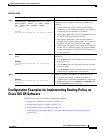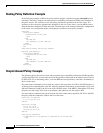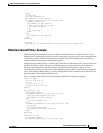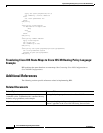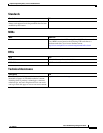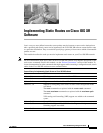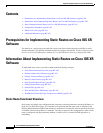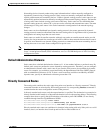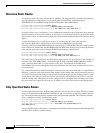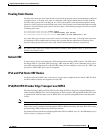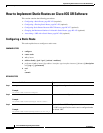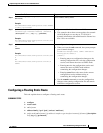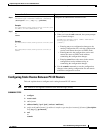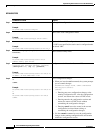
Implementing Static Routes on Cisco IOS XR Software
Information About Implementing Static Routes on Cisco IOS XR Software
RC-421
Cisco IOS XR Routing Configuration Guide
OL-14356-01
Networking devices forward packets using route information that is either manually configured or
dynamically learned using a routing protocol. Static routes are manually configured and define an
explicit path between two networking devices. Unlike a dynamic routing protocol, static routes are not
automatically updated and must be manually reconfigured if the network topology changes. The benefits
of using static routes include security and resource efficiency. Static routes use less bandwidth than
dynamic routing protocols, and no CPU cycles are used to calculate and communicate routes. The main
disadvantage to using static routes is the lack of automatic reconfiguration if the network topology
changes.
Static routes can be redistributed into dynamic routing protocols, but routes generated by dynamic
routing protocols cannot be redistributed into the static routing table. No algorithm exists to prevent the
configuration of routing loops that use static routes.
Static routes are useful for smaller networks with only one path to an outside network and to provide
security for a larger network for certain types of traffic or links to other networks that need more control.
In general, most networks use dynamic routing protocols to communicate between networking devices
but may have one or two static routes configured for special cases.
Note For information on configuring static routes to distribute Multiprotocol Label Switching (MPLS)
Layer 3 virtual private network (VPN) information, see Cisco IOS XR Multiprotocol Label Switching
Configuration Guide.
Default Administrative Distance
Static routes have a default administrative distance of 1. A low number indicates a preferred route. By
default, static routes are preferred to routes learned by routing protocols. Therefore, you can configure
an administrative distance with a static route if you want the static route to be overridden by dynamic
routes. For example, you could have routes installed by the Open Shortest Path First (OSPF) protocol
with an administrative distance of 120. To have a static route that would be overridden by an OSPF
dynamic route, specify an administrative distance greater than 120.
Directly Connected Routes
The routing table considers the static routes that point to an interface as “directly connected.” Directly
connected networks are advertised by IGP routing protocols if a corresponding interface command is
contained under the router configuration stanza of that protocol.
In directly attached static routes, only the output interface is specified. The destination is assumed to be
directly attached to this interface, so the packet destination is used as the next hop address. The following
example shows how to specify that all destinations with address prefix 2001:0DB8::/32 are directly
reachable through interface GigabitEthernet 0/5/0/0:
RP/0/RP0/CPU0:router(config)# router static
RP/0/RP0/CPU0:router(config-static)# address-family ipv6 unicast
RP/0/RP0/CPU0:router(config-static-afi)# 2001:0DB8::/32 gigabitethernet 0/5/0/0
Directly attached static routes are candidates for insertion in the routing table only if they refer to a valid
interface; that is, an interface that is both up and has IPv4 or IPv6 enabled on it.



